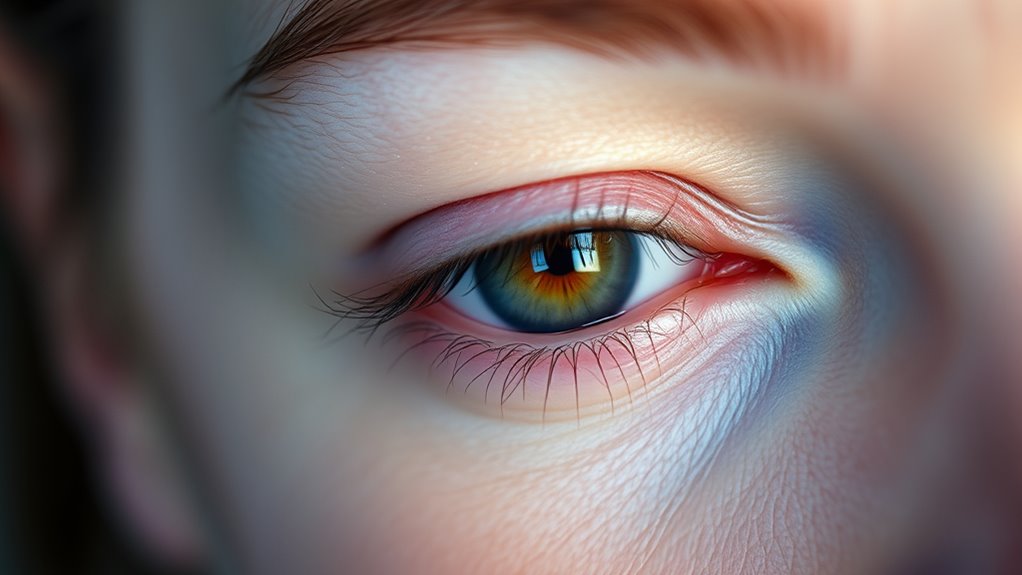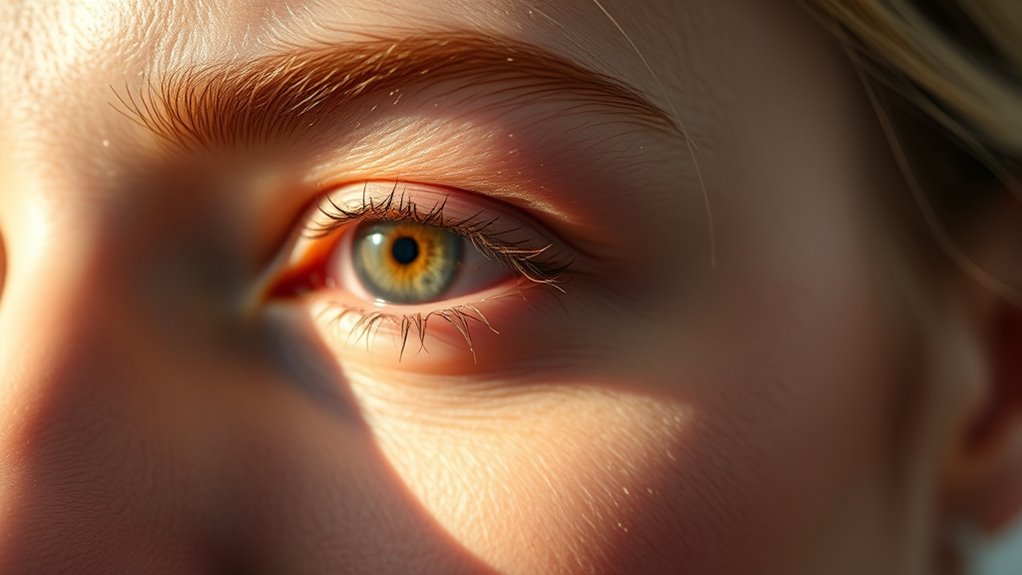Retinol can help improve the delicate skin around your eyes if used cautiously. Start with a low concentration, applying it 2-3 times a week at night, and avoid the eyelids unless advised otherwise. Use gentle techniques, like patting with your ring finger, and follow with soothing eye creams. Pay attention to how your skin responds, and don’t increase frequency too quickly. If you’re curious about finding the safest approach and proper strengths, there’s more to discover.
Key Takeaways
- Use low-strength retinol formulations near the eyes to minimize irritation and gradually build tolerance.
- Apply retinol 2-3 times weekly at night, increasing frequency as skin adapts.
- Avoid applying retinol directly on eyelids unless specifically formulated for that area.
- Combine retinol with soothing ingredients like hyaluronic acid and peptides to reduce dryness and redness.
- Proper application techniques, such as gentle patting with the ring finger, enhance safety and effectiveness.

Are you considering using retinol around your eyes? If so, you’re likely curious about how safe it is and what strengths are appropriate. The skin around your eyes is delicate, so understanding the right ingredient combinations and application techniques can make all the difference in achieving benefits without irritation. Retinol, a powerful form of vitamin A, can help reduce fine lines, wrinkles, and dark circles, but misuse can lead to redness, dryness, or peeling. To get the most out of retinol near your eyes, start with a low concentration and gradually increase as your skin builds tolerance. This approach minimizes irritation and allows you to observe how your skin responds over time.
When it comes to ingredient combinations, it’s crucial to pair retinol carefully. Avoid using it alongside harsh ingredients like alcohol, fragrances, or strong acids, which can exacerbate dryness and irritation. Instead, look for soothing ingredients like hyaluronic acid, peptides, or ceramides to support your skin barrier and enhance hydration. Incorporating antioxidants such as vitamin C in your daytime routine can also boost your skin’s resilience, but use retinol at night to avoid potential interactions. Remember, layering is key; apply retinol sparingly and follow up with a rich, hydrating eye cream to lock in moisture and protect your skin.
Application techniques are just as important as ingredient choices. Use your ring finger—it’s the gentlest—when applying retinol around your eyes. Take a tiny amount—just a pea-sized drop for both eyes—and gently pat, avoiding any rubbing or pulling. Focus on areas with fine lines or dark circles, but steer clear of the eyelid itself unless your product specifically states it’s safe for that sensitive area. Always ensure your skin is clean and dry before application to prevent irritation. Applying retinol over damp skin can increase absorption, but it also heightens the risk of irritation, so proceed cautiously. It’s best to start by applying retinol 2-3 times a week, gradually increasing frequency as your skin adapts. Additionally, understanding the importance of contrast ratio can help you choose the right formulation that enhances image clarity and reduces potential irritation from overly harsh products.
Frequently Asked Questions
Can Retinol Cause Permanent Damage Around the Eyes?
Retinol can cause eye irritation and skin sensitivity if misused or applied too close to the eyes. While it rarely causes permanent damage, overuse or using a product with a high concentration might lead to lasting skin issues. To avoid problems, you should start with a gentle formula, apply it carefully, and avoid sensitive areas. Always patch-test new products and consult a dermatologist if you experience persistent irritation.
How Long Does It Take to See Results From Retinol Near the Eyes?
Think of retinol absorption near your eyes as planting a seed—patience helps it grow. You might start noticing smoother skin or reduced fine lines in about 4 to 6 weeks, but visible results often take up to 12 weeks. Because your eye area is sensitive, use retinol carefully, and don’t rush the process. Consistent, gentle application allows your skin to adapt and reveal its true glow over time.
Are There Any Natural Alternatives to Retinol for Eye Area?
If you’re looking for natural alternatives to retinol for your eye area, consider plant-based ingredients and herbal remedies. You can try products with ingredients like aloe vera, chamomile, or green tea, which soothe and hydrate the skin. These options are gentler and can help reduce puffiness or fine lines. While they may not deliver instant results, consistent use can improve your skin’s appearance naturally and safely.
How Often Should I Apply Retinol Near My Eyes?
You should start by applying retinol near your eyes once or twice a week to minimize eye irritation. Gradually increase usage as your skin tolerates it, but always be cautious. Remember, using sunscreen daily is essential since retinol can increase sun sensitivity. If you notice redness or irritation, cut back on application frequency and consult a dermatologist for personalized advice.
Can Retinol Be Used With Other Eye Creams or Treatments?
Think of your skincare routine as a symphony; each product should harmonize, not clash. When considering eye cream combinations, you need to be aware of treatment interactions. Retinol can work well with some eye creams, but combining it with others might cause irritation. Always check ingredient lists and consult your dermatologist. Using retinol carefully guarantees your delicate eye area stays healthy and glowing without discord.
Conclusion
So, if you think applying retinol near your eyes is just a small skincare step, think again. This tiny tube of magic can unseal a fountain of youth, erase years in seconds, and turn back time faster than you ever imagined. But remember, with great power comes great responsibility—use it wisely, or you might just wake up looking like a completely different person! Treat your skin with care, and watch miracles unfold.










